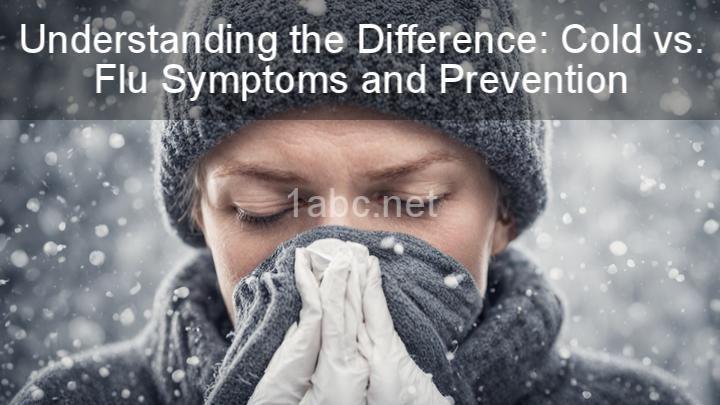Understanding the Difference: Cold vs. Flu Symptoms and Prevention

Introduction:
Welcome readers to our blog post on understanding the difference between cold and flu symptoms, as well as effective prevention methods. In today's fast-paced world, it's crucial to be able to differentiate between these two common illnesses for better health management. By knowing the distinction, you can take appropriate measures to prevent the spread of viruses and ensure a faster recovery. In this blog post, we will provide you with detailed information in a friendly tone, helping you become more informed about cold and flu symptoms and the necessary steps to take for prevention.
I. What is a Cold?
A. Definition and Common Symptoms:
A cold is a viral infection that primarily affects the upper respiratory system, including the nose and throat. It is caused by various viruses, with the most common being rhinovirus. Colds are typically of short duration and resolve within a week. Symptoms can vary from person to person, but common signs of a cold include:
- Sneezing: Frequent and uncontrollable sneezing is a typical symptom of a cold.
- Runny or Stuffy Nose: Nasal congestion and a runny nose are common cold symptoms.
- Sore Throat: A scratchy or irritated feeling in the throat is often present during a cold.
- Coughing: A mild cough can be associated with a cold.
- Mild Fatigue: Feeling tired or slightly drained of energy is a common cold symptom.
B. How Does a Cold Spread?
Cold viruses are primarily transmitted through close contact with infected individuals or by touching contaminated surfaces. When an infected person coughs or sneezes, respiratory droplets containing the cold virus are released into the air. These droplets can be inhaled by others nearby, leading to infection. Alternatively, if an infected person touches their nose or mouth and then touches an object or surface, the virus can be transferred to that object. If someone else touches the contaminated object and then touches their nose or mouth, they can contract the virus as well. Practicing good hygiene, such as regular handwashing and avoiding close contact with those who are sick, is essential to prevent spreading or contracting a cold.
II. What is the Flu?
A. Definition and Typical Symptoms:
The flu, short for influenza, is a viral infection caused by influenza viruses. It affects the respiratory system, including the nose, throat, and sometimes the lungs. Influenza is known for its more severe symptoms compared to a cold and can result in serious complications. Typical symptoms of the flu include:
- High Fever: A sudden and high fever, often above 100.4°F (38°C), is a hallmark symptom of the flu.
- Severe Fatigue: Feeling extremely tired and having low energy levels is common with the flu.
- Body Aches: Muscle and body aches are more prominent during the flu.
- Chills: Experiencing sudden coldness and chills is a typical flu symptom.
- Headache: A persistent headache, often accompanied by sinus pressure, can occur with the flu.
- Respiratory Issues: Some individuals may experience respiratory symptoms such as a cough, sore throat, and congestion.
B. How Does the Flu Spread?
The flu is highly contagious and can be transmitted through respiratory droplets when an infected person coughs, sneezes, or talks. These droplets can then be inhaled by others nearby, leading to infection. Additionally, the flu virus can also spread by touching contaminated surfaces or objects that have the virus on them and then touching the nose, mouth, or eyes. Taking necessary precautions such as covering your mouth and nose when coughing or sneezing, using tissues or your elbow, and regular handwashing can help prevent the spread of the flu virus.
III. Key Differences Between Colds and Flu:
A. Severity of Symptoms:
One of the key differences between a cold and the flu is the severity of symptoms. Flu symptoms are generally more severe compared to those of a common cold. While both illnesses may include symptoms like coughing and fatigue, the flu often presents with more intensity. Flu symptoms can be debilitating, causing extreme fatigue and severe body aches that make it difficult to carry out daily activities. Additionally, the flu can also lead to complications such as pneumonia, which is rare with a common cold. It's important to recognize these differences to seek appropriate medical care and take necessary precautions to prevent the spread of the flu.
B. Onset of Symptoms:
The onset of symptoms is another distinguishing factor between a cold and the flu. With a common cold, symptoms often develop gradually over several days. You may start with a scratchy throat, followed by sneezing, a runny or stuffy nose, and then a mild cough. In contrast, flu symptoms tend to appear suddenly and intensely. You may wake up one morning feeling fine but then suddenly experience a high fever, severe body aches, and extreme fatigue. The rapid onset of flu symptoms can be alarming, and it's important to take appropriate measures to prevent further spread of the virus.
C. Duration of Illness:
While most colds resolve within a week, the flu can last longer with more intense symptoms. A cold typically lasts for about 7-10 days, with symptoms gradually improving over time. In contrast, the flu can last for one to two weeks, and the recovery process may take even longer due to the severity of symptoms. It's important to rest, stay hydrated, and follow medical advice to ensure a full recovery from the flu.
IV. Prevention Methods:
A. General Preventive Measures:
Preventing the spread of both the cold and flu viruses requires practicing good hygiene and taking certain precautions. Here are some general preventive measures you can adopt:
- Regular Handwashing: Wash your hands frequently with soap and water for at least 20 seconds, especially before eating, after using the restroom, and after being in public spaces.
- Avoid Close Contact: Try to avoid close contact with individuals who are sick, especially if they have respiratory symptoms.
- Cover Coughs and Sneezes: Cover your mouth and nose with a tissue or your elbow when coughing or sneezing to prevent respiratory droplets from spreading. Dispose of used tissues immediately.
- Hand Sanitizers: If soap and water are not readily available, use an alcohol-based hand sanitizer that contains at least 60% alcohol.
- Disinfect Surfaces: Clean and disinfect frequently-touched surfaces such as doorknobs, light switches, and smartphones regularly to reduce the risk of contamination.
B. Flu Vaccination:
Getting an annual flu vaccine is one of the most effective ways to prevent the flu and its complications. The flu vaccine stimulates the immune system to produce antibodies against the influenza virus strains expected to circulate that year. It significantly reduces the risk of contracting the flu and, if you do get infected, can lessen the severity and duration of symptoms. It's important to note that the flu vaccine does not protect against the common cold or other respiratory viruses. However, it is highly recommended to protect against the more severe and potentially dangerous influenza viruses. It is a safe and well-studied vaccine, and common concerns or misconceptions about flu vaccines should not deter anyone from getting vaccinated.
V. When to Seek Medical Attention:
While most colds and flu can be managed at home with rest, fluids, and over-the-counter medications, there are instances when seeking medical attention is necessary. It's important to monitor your symptoms and consult a healthcare professional if:
- Flu Symptoms Worsen: If your flu symptoms worsen over time instead of improving, it may indicate a secondary bacterial infection or other complications.
- Difficulty Breathing: If you are experiencing difficulty breathing, chest pain, or persistent coughing, it's essential to seek medical attention promptly.
- Underlying Health Conditions: Individuals with underlying health conditions, such as asthma, diabetes, or heart disease, should consult a healthcare professional if they develop cold or flu symptoms.
- High-Risk Groups: Pregnant women, young children, older adults, and individuals with weakened immune systems should seek medical attention if they develop cold or flu symptoms.
Conclusion:
In conclusion, understanding the difference between cold and flu symptoms is crucial for better health management. While both illnesses are respiratory infections caused by viruses, the flu is generally more severe and can lead to complications. Recognizing the specific symptoms and distinguishing factors between a cold and the flu can help you take appropriate measures for prevention and seek medical attention when necessary. Practicing good hygiene, getting an annual flu vaccine, and following general preventive measures can significantly reduce the risk of contracting and spreading these common illnesses. Stay informed, stay healthy, and remember to take care of yourself and others around you.
Thank you for reading our blog post. We hope you found it informative and helpful. Feel free to share your experiences or any questions you may have in the comments section below. Stay well!
FREQUENTLY ASKED QUESTIONS
What are the common symptoms of a cold?
Common symptoms of a cold include:
- Runny or stuffy nose
- Sneezing
- Coughing
- Sore throat
- Mild headache
- Fatigue or tiredness
- Mild body aches
- Low-grade fever (in some cases)
- Watery eyes
- Mild difficulty in breathing (in some cases)
It's important to note that symptoms can vary from person to person, and not everyone may experience all of these symptoms. Additionally, these symptoms are often milder compared to other respiratory illnesses such as the flu.
How can I differentiate between a cold and the flu?
Differentiating between a cold and the flu can be challenging because both are respiratory illnesses and share similar symptoms. However, there are some key differences you can look out for:
- Onset: The flu usually has a sudden onset with symptoms appearing rapidly, while a cold typically develops gradually over a few days.
- Fever: High fever (above 100.4°F or 38°C) is commonly associated with the flu but is less common in colds or may be mild.
- Fatigue: The flu often causes significant fatigue and exhaustion, which can last for several weeks. Fatigue with a cold is usually mild.
- Body aches: Severe muscle or body aches are more common with the flu and less common with a cold.
- Headache: Although headaches can occur with both, they are more common with the flu and often intense.
- Runny or stuffy nose: These symptoms are typical for a cold but less common in the flu.
- Sneezing and sore throat: These symptoms are more common in a cold than in the flu.
It's worth mentioning that individual experiences may vary, and these are general guidelines to differentiate between a cold and the flu. If you are unsure or have severe symptoms, it's best to consult a healthcare professional for an accurate diagnosis.
What are the typical symptoms of the flu?
The typical symptoms of the flu include:
- Fever
- Cough
- Sore throat
- Runny or stuffy nose
- Body aches
- Fatigue
- Headache
- Chills
- Sometimes diarrhea and vomiting (more common in children than adults)
It is important to note that these symptoms can vary in severity and may overlap with other respiratory illnesses. If you are experiencing flu-like symptoms, it is best to consult with a healthcare professional for an accurate diagnosis and appropriate treatment.
How long do cold symptoms usually last?
Cold symptoms typically last between 7 to 10 days. However, the duration may vary depending on the individual and the severity of the cold. It's important to note that if your symptoms persist for more than 10 days or worsen, it is advisable to consult a healthcare professional for further evaluation and guidance.

